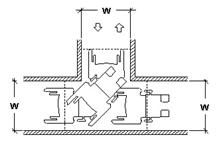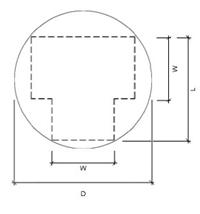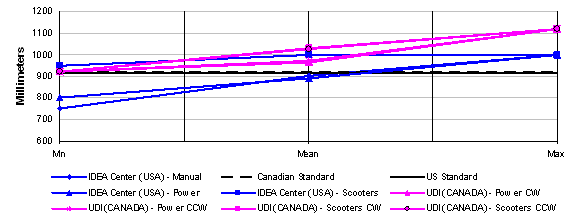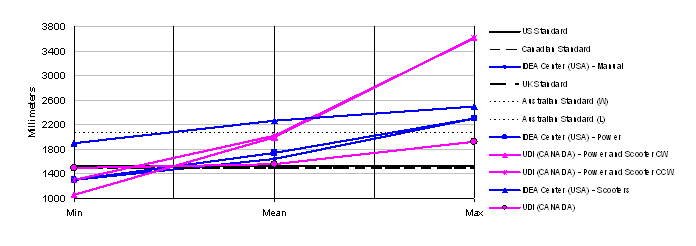4.5 Maneuvering Clearances
Figures 28-29 and Tables 7-8 show the standards from the four countries related to maneuvering clearances from a wheeled mobility device. Figures 30-32 show key findings from the research.
Figure 28
Table 7.
|
|
U.S. |
Australia |
Canada |
U.K. |
|
Width (W) |
915 |
X |
920 |
X |
Figure 29
Table 8.
|
|
U.S. |
Australia |
Canada |
U.K. |
|
Diameter (circular) |
1525 |
X |
1500 |
1500 |
|
Width (W) |
X |
1540 |
X |
X |
|
Length (L) |
X |
2070 |
X |
X |
Figure 30. 90 Degree (“L-Turn”) for All Devices
Note: IDEA Center values “max out” at 1000 mm due to experimental protocol
Figure 31-32. “U-Turn” for All Devices
Only the U.S. and Canada have requirements for 90 degree or L-Turn clearances. All the standards have requirements for “wheelchair turning spaces.” Canada includes guidelines for both a 360 degree turn and a 180 degree turn. But, it is not clear, how the different standards define these turns. For example, when should one plan for a 360 degree turn as opposed to a 180 degree turn? Australia defines a rectangular area where the other countries have adopted a circular or “T-turn” geometries. Canada and the U.K. have added informative sections with more advisory information on maneuvering space requirements. This advisory data is based on the research reported in the UDI report and BS8300 Annex respectively.
The clearance required for all participants to complete a 90 degree turn by the IDEA sample was much smaller than the UDI findings. An increase in the clear width criterion of 100 mm (4 in.) would be needed to accommodate the entire IDEA sample. However, to accommodate the entire UDI sample, an increase of 300 mm (12 in.) would be needed. The UDI findings at the high end of the range probably reflect the impact of a few participants or devices with very poor turning ability.
The IDEA protocol included only a 360 degree turn but the UDI study included a 180 degree turn as well. The BS8300 reports only the latter but doesn’t define it. The IDEA and BS8300 results demonstrated that turning area clearances would have to be increased to 2400 mm (94.5 in.) compared to the current 1500-1525 mm (60 in.) to accommodate their entire samples. To accommodate the UDI sample for a 180 degree turn, the required turning space would only have to be increased to 1925 mm (75.8 in.). However, in the UDI research protocol, the ends of the turn were open, allowing the participants to lengthen out their turn and reduce its width. In comparison, the UDI participants utilized a much larger space for the 360 degree turn, in which no sides were blocked. A space about 4200 mm (165 in.) would be needed to accommodate the entire sample. In the IDEA sample, scooters require more space but the largest values for scooters, power chairs and manual chairs were very close whereas in the UDI sample, at least one power wheelchair user required a much larger clearance for the 360 degree turn. Because the UDI protocol for the 360 degree turn was not bounded by walls, participants could extend their arms and legs beyond the envelope of the chair. With a bounded area, many of these individuals may have been able to pull their extremities closer to their body during the turn.
The results support increasing the clearances for 90 degree turns and 180 degree turns. However, it appears that there are some people at the tail of the distribution who require much larger spaces than even the 95th percentile values. More detailed information on who these individuals are and the size of their devices is needed. They may be very restricted in their abilities to maneuver chairs independently. It is important to note that these individuals use all three types of devices. We observed some manual wheelchair users who had very restricted push arcs. This limited their ability to maneuver a chair and resulted in wide turning circles.
The differences between the UDI findings and the other studies suggest great differences in their protocol or measurement technique. This may be due to the lack of an enclosure in the 360 degree turn, errors in correcting for parallax when measuring from video cameras mounted above, or inability to obtain accurate measurements of body parts and devices in motion.
Recommendations
- Clearances for L-turns should be increased 100 mm (4 in.).
- The intent and applications of the wheelchair turning area needs to be more clearly defined.
- Clearances for wheeled mobility device turns should be increased but accommodating the entire population of wheeled mobility users may result in very restrictive requirements.






User Comments/Questions
Add Comment/Question